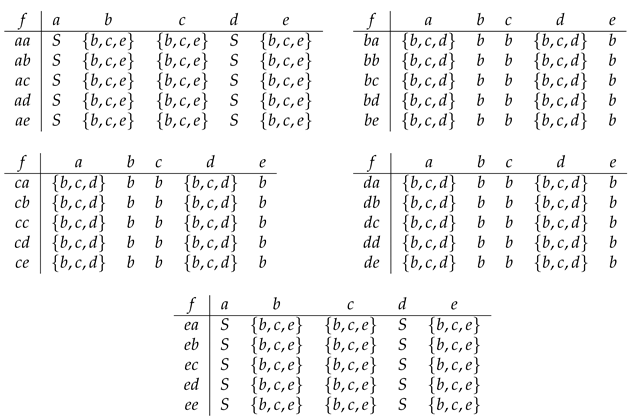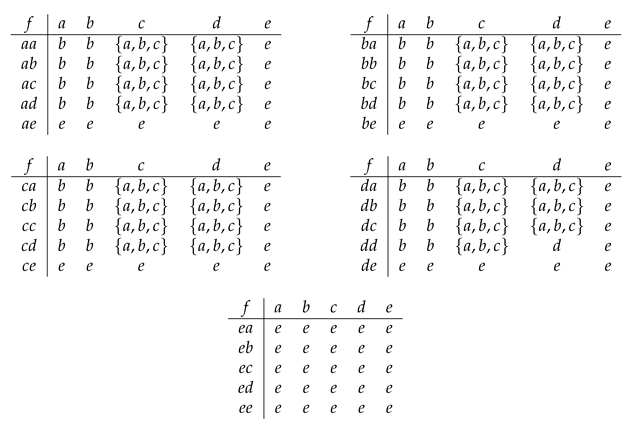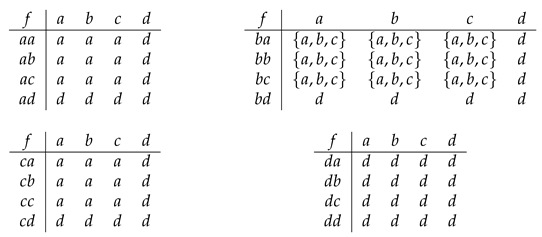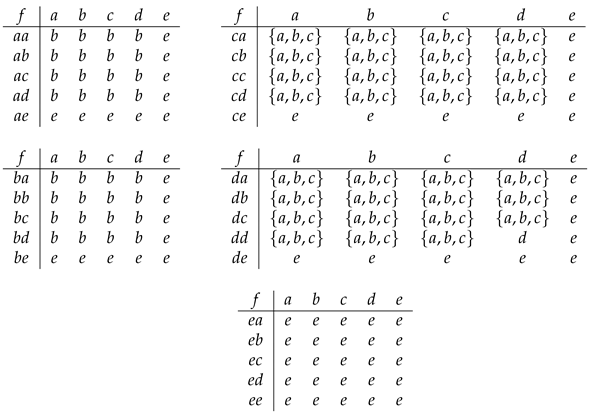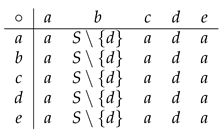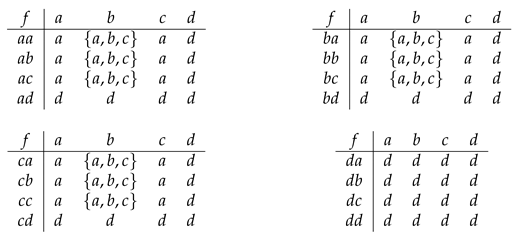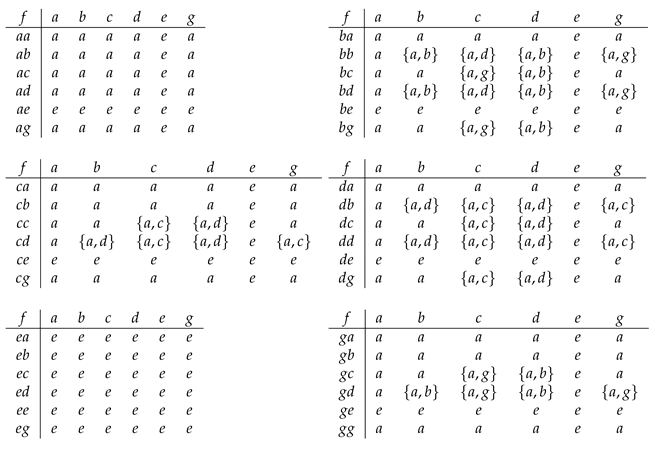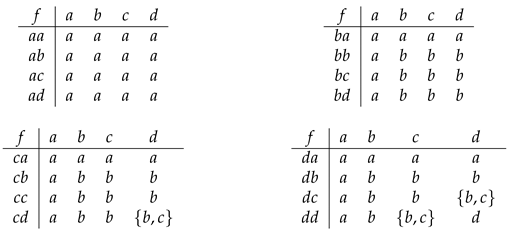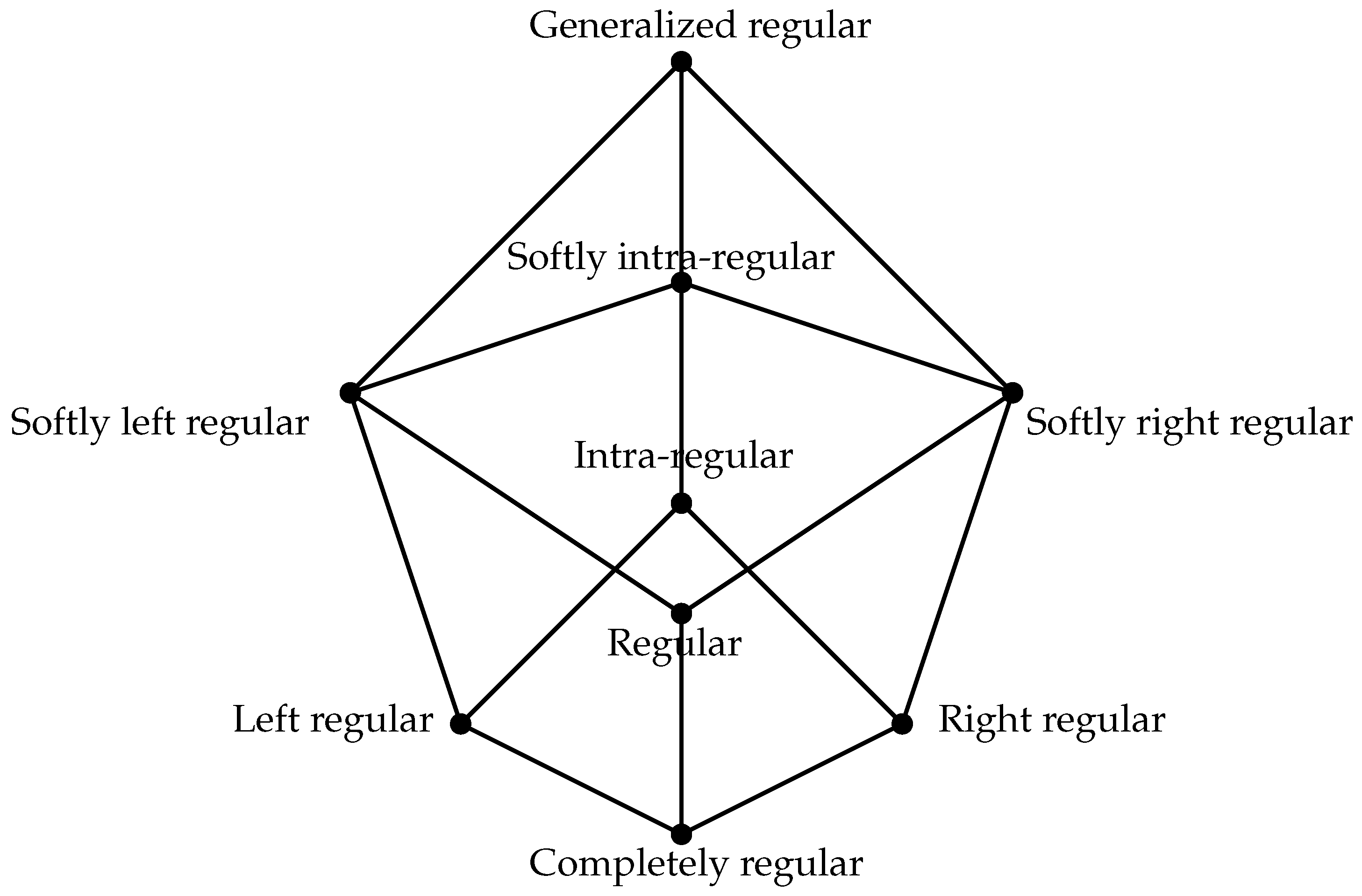3. Regularities in Ordered n-Ary Semihypergroups
In this section, we introduce different types of regularity of ordered
n-ary semihypergroups and investigate the characterization of them in terms of
j-hyperideals for
and
. According to the notion of regular
n-ary semigroups (without order), where
, which was studied by Dudek and Groźdińska [
3], the following definition is a generalization of such a notion on ordered
n-ary semihypergroups where
.
Definition 3. Let S be an ordered n-ary semihypergroup with . An element is called regular if there exist such that . S is called regular if every elements of S is regular, i.e., S is regular if and only if for all .
Theorem 1. Let S be an ordered n-ary semihypergroup with . Then, the following statements are equivalent.
- (i)
S is regular;
- (ii)
for all j-hyperideals of S;
- (iii)
for all ;
- (iv)
for all .
Proof. The proof is similar to Theroem 1 in [
3]. □
Next, we introduce the concepts of left regular, right regular and intra-regular ordered n-ary semihypergroups, where . To introduce the notion of intra-regular ordered n-ary semihypergroups, the following properties are needed.
Lemma 3. Let S be an ordered n-ary semihypergroup with . For any positive integer , the following statements are equivalent.
- (i)
For each there exist such that ;
- (ii)
For each there exist such that .
Proof. Let
and let
j be a fixed positive integer satisfying
and
.
Let
for some
. Firstly, we show that
for some
. For case
and
, we are done. Suppose that
and
, by associativity and Lemma 1, we have
where
and
,
.
It follows that
for some
Then, there exist
such that
, where
. Thus,
. Next, we consider
This means that
for some
Then, there exists such that , , where Therefore,
Let
for some
. By associativity, we have
This means that for some , where and and . It follows that Next, we show that .
For case and , we have .
For case
and
, we have
Consequently, there exists such that where , and . Therefore, □
Without loss of generality, we introduce the notion of intra-regular ordered n-ary semihypergroups, where , as follows.
Definition 4. Let S be an ordered n-ary semihypergroup with . Let .
- (i)
a is called left regular if there exist such that ;
- (ii)
a is called right regular if there exist such that ;
- (iii)
a is called intra-regular if it satisfies one of the equivalent conditions in Lemma 3.
Furthermore, S is said to be (left regular, right regular) intra-regular if every element of S is (left regular, right regular) intra-regular.
Clearly, the concept of an intra-regular ordered ternary semihypergroup, which was introduced in Definition 2.29 [
31], is equal to Definition 4(iii) (for
) under the condition (i) of Lemma 3. Moreover, if we consider any ordered
n-ary semigroup as an ordered
n-ary semihypergroup, then Definition 8 in [
5] and Definition 4(iii) under the condition (ii) of Lemma 3 coincide.
Remark 1. Let S be an ordered n-ary semihypergroup with . Then, the following statements hold.
- (i)
S is left regular if and only if for all ;
- (ii)
S is right regular if and only if for all ;
- (iii)
S is intra-regular if and only if one of the following two conditions holds.
- (1)
For any , for all .
- (2)
for all .
Example 1. Let . Define a ternary hyperoperation by the following tableand define a partial order on S as follows Then, is a left regular ordered ternary semihypergroup. Moreover, it is not difficult to show that is also a right regular ordered ternary semihypergroup.
Example 2. Let . Define a ternary hyperoperation by the following tableand define a partial order on S as follows Then, is an intra-regular ordered ternary semihypergroup.
Theorem 2. S is left regular (right regular, respectively) if and only if every n-hyperideal (1-hyperideal, respectively) of S is semiprime.
Proof. Let A be an n-hyperideal of S. Let such that . Since S is left regular, there exist such that Thus, A is semiprime. Conversely, suppose that every n-hyperideal of S is semiprime: let . Clearly, is an n-hyperideal of S. Since , we have . From Remark 1, we conclude that S is a left regular ordered n-ary semihypergroup. □
Theorem 3. S is intra-regular if and only if for all n-hyperideals A, 1-hyperideals B of S and .
Proof. Let
S be an intra-regular ordered
n-ary semihypergroup with
. Let
A be an
n-hyperideal,
B be a 1-hyperideal of
S and
. Suppose that
: since
S is intra-regular, there exist
such that
. Since
, we have
. Similarly, since
, we obtain
. Since
, we have
and then
. Conversely, let
. From Lemmas 1 and 2, we have
Case 1: . Then,
Case 2: . Then, ,
Case 3: . Using the similar proof as in Case 2, we obtain
From Cases 1 to 3 and Lemma 1(iii), we conclude that S is intra-regular. □
Definition 5. Let S be an ordered n-ary semihypergroup with . S is called completely regular if S is regular, left regular and right regular.
Example 3. Let . Define a ternary hyperoperation by the following tableand define a partial order on S as follows Then, is a completely regular ordered ternary semihypergroup.
Lemma 4. S is completely regular if and only if for all .
Proof. Let S be a completely regular ordered n-ary semihypergroup and . Since S is regular, we have . Since S is left regular and right regular, by Remark 1(i) and (ii), we have and . It follows that Conversely, let . Then, . So S is regular. Furthermore, we have . From Remark 1(ii), S is right regular. Clearly, . From Remark 1(ii), S is left regular. Therefore, S is completely regular. □
Next, we introduce the concept of softly left, softly right and softly intra-regular ordered n-ary semihypergroups, which are generalizations of left, right and intra-regular ordered n-ary semihypergroups, where .
Definition 6. Let S be an ordered n-ary semihypergroup with . Let .
- (i)
a is called softly left regular if there exist such that - (ii)
a is called softly right regular if there exist such that - (iii)
a is called softly intra-regular if there exist such that
Additionally, S is called (softly left regular, softly right regular) softly intra-regular if each element of S is (softly left regular, softly right regular) softly intra-regular.
Remark 2. Let S be an ordered n-ary semihypergroup with . Then, the following statements hold.
- (i)
S is softly left regular if and only if for all ;
- (ii)
S is softly right regular if and only if for all ;
- (iii)
S is softly intra-regular if and only if for all .
Example 4. Let . Define a ternary hyperoperation by the following tableand define a partial order on S as follows Then, is a softly left regular ordered ternary semihypergroup.
Example 5. Let . Define a ternary hyperoperation by the following tableand define a partial order on S as follows Then, is a softly intra-regular ordered ternary semihypergroup.
Theorem 4. Let S be an ordered n-ary semihypergroup with . Then, the following statements are equivalent.
- (i)
S is softly left regular.
- (ii)
For any positive integer , for all j-hyperideals and all n-hyperideals of S.
- (iii)
for all n-hyperideals of S.
Proof. Let
j be a fixed positive integer such that
and
. Let
be a
j-hyperideal and
be an
n-hyperideal of
S and
. Since
S is softy left regular, there exist
such that
. By associativity, we have
Consequently, .
It is obvious.
Let . Then, . We have four cases to be considered as follows.
Case 1: . Then, we have .
Case 2: . Then, we have .
Case 3: . Then, we have .
Case 4: . Then, we have , .
From Cases 1 to 4 and Remark 2(i), S is softly left regular. □
Using the similar proof of Theorem 4, we obtain the following result.
Theorem 5. Let S be an ordered n-ary semihypergroup with . Then, the following statements are equivalent.
- (i)
S is softly right regular;
- (ii)
For any positive integer , for all 1-hyperideals and all j-hyperideals of S;
- (iii)
for all 1-hyperideals of S.
Theorem 6. Let S be an ordered n-ary semihypergroup with . Then, the following statements are equivalent.
- (i)
S is softly intra-regular.
- (ii)
For any positive integer and , for all i-hyperideals and all j-hyperideals of S.
- (iii)
For any positive integer , for all k-hyperideals of S.
Proof. Let
be two fixed positive integers such that
and
. Let
be an
i-hyperideal and
be a
j-hyperideal of
S and
. Since
S is softly intra-regular, there exist
such that
. By associativity, we have
On the other hand, we have
Thus, .
It is obvious.
Let . Then, .
We consider the following cases.
Case 1:
for some
. Then,
Case 2:
for some
. Then,
Case 3: . The proof is similar to Case 2.
Case 4: . Then, .
From Cases 1 to 4 and Remark 2(iii), we conclude that S is softly intra-regular. □
Definition 7. Let S be an ordered n-ary semihypergroup with . An element is called generalized regular if there exist such that . S is called generalized regular if every element of S is generalized regular, i.e., S is generalized regular if and only if for all .
Example 6. Let . Define a ternary hyperoperation by , for all , where ∘ is defined by the following tableand define a partial order on S as follows Then, is a generalized regular ordered ternary semihypergroup.
Theorem 7. S is generalized regular if and only if for each , for all j-hyperideals of S.
Proof. Firstly, let
j be a fixed positive integer satisfying
. Let
be a
j-hyperideal of
S and
. Since
S is generalized regular, there exist
such that
Thus, . Conversely, let . Then, . We have two cases to be considered, as follows.
Case 1: for some .
If , then .
By associativity, we have
Case 2: . Then,
Next, we consider the following cases.
If and , then we are done.
If and , then
If
and
, then
Therefore, S is generalized regular. □
Finally, we establish the relationships between regularities in ordered n-ary semihypergroups, where , as follows.
Lemma 5. Let S be an ordered n-ary semihypergroup with . Then, the following statements hold.
- (i)
Every left (right) regular is intra-regular;
- (ii)
Every regular is softly left (right) regular;
- (iii)
Every left (right) regular is softly left (right) regular;
- (iv)
Every softly left (right) regular is softly intra-regular;
- (v)
Every intra-regular is softly intra-regular;
- (vi)
Every softly intra-regular is generalized regular.
Proof. (i) Let S be a left regular ordered n-ary semihypergroup. Then, there exist such that . Consequently, by Remark 1, we conclude that S is intra-regular.
(ii) Let S be a regular ordered n-ary semihypergroup. Then, there exist such that . From Remark 2(i), S is softly left regular.
The proofs of (iii)–(vi) are obvious. □
The following examples show that the converse assertions of Lemma 5 do not hold true in general.
Example 7. We know that an ordered ternary semihypergroup , as given in Example 2, is an intra-regular ordered ternary semihypergroup. Since , we have . From Remark 1, we conclude that is not a left regular ordered ternary semihypergroup. This shows that the converse statement of Lemma 5(i) does not hold.
Example 8. Let . Define a ternary hyperoperation by the following tableand define a partial order on S as follows Then, is an ordered ternary semihypergroup. Clearly, , , and By Definition 6, is a softly right ordered ternary semihypergroup. On the other hand, since , by Definition 3, we conclude that is not a regular ordered ternary semihypergroup. This shows that the reverse assertion of Lemma 5(ii) is not true.
Example 9. We know that an ordered ternary semihypergroup that has been given in Example 6 is a generalized regular ordered ternary semihypergroup. Clearly, is a 3-hyperideal of S. Looking at the table, one can immediately see that . It follows that . From Theorem 4, we conclude that is not a softly left regular ordered ternary semihypergroup.
Example 10. We know that an ordered ternary semihypergroup , which was given in Example 1, is a left regular and right regular ordered ternary semihypergroup. Since , by Lemma 4, we conclude that is not a completely regular ordered ternary semihypergroup.
Example 11. Let . Define a ternary hyperoperation by the following tableand define a partial order on S as follows Then, is an ordered ternary semihypergroup. Evidently, and S are all a 1-hyperideal of S. It is not difficult to show that , and . From Theorem 5, we conclude that is a softly right regular ordered ternary semihypergroup. Since but , we find that A is not a semiprime 1-hyperideal of S. From Theorem 2, is not a right regular ordered ternary semihypergroup. This shows that the converse assertion of Lemma 5(iii) is not true in general.
Example 12. We know that an ordered ternary semihypergroup that has been given in Example 5 is a softly intra-regular ordered ternary semihypergroup. Obviously, is a 1-hyperideal of S. Since , by Theorem 5, we conclude that is not a softly right regular ordered ternary semihypergroup, which verifies that the converse statement of Lemma 5(iv) does not hold.
Example 13. Let . Define a ternary hyperoperation by the following tableand define a partial order on S as follows Then, is an ordered ternary semihypergroup. Clearly, and S are all 2-hyperideals of S. It is easy to show that . From Theorem 6, is a softly intra-regular ordered ternary semihypergroup. However, is not an intra-regular ordered ternary semihypergroup. In fact, there exist a n-hyperideal , an 1-hyperideal and a nonempty subset of S such that . From Theorem 3, we conclude that is not an intra-regular ordered ternary semihypergroup. This shows that the converse statement of Lemma 5(v) does not satisfy.
Example 14. Let . Define a ternary hyperoperation by the following tableand define a partial order on S as follows Then, is an ordered ternary semihypergroup. Clearly, and S are all 2-hyperideals of S. It is not difficult to see that for all 2-hyperideals A of S. From Theorem 7, is a generalized regular ordered ternary semihypergroup. On the other hand, S is not a softly intra-regular ordered ternary semihypergroup. In fact, since is an 2-hyperideal of S and , by Theorem 6, we conclude that is not a softly intra-regular ordered ternary semihypergroup. This shows that the reverse assertion of Lemma 5(vi) does not hold true in general.
